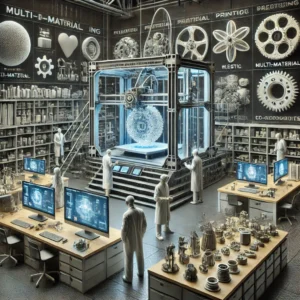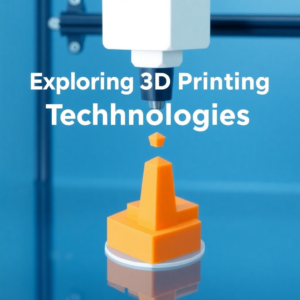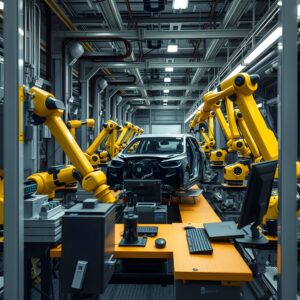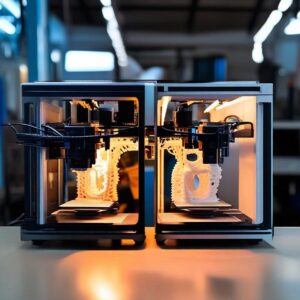3D Printing’s Impact on Product Design in 2024
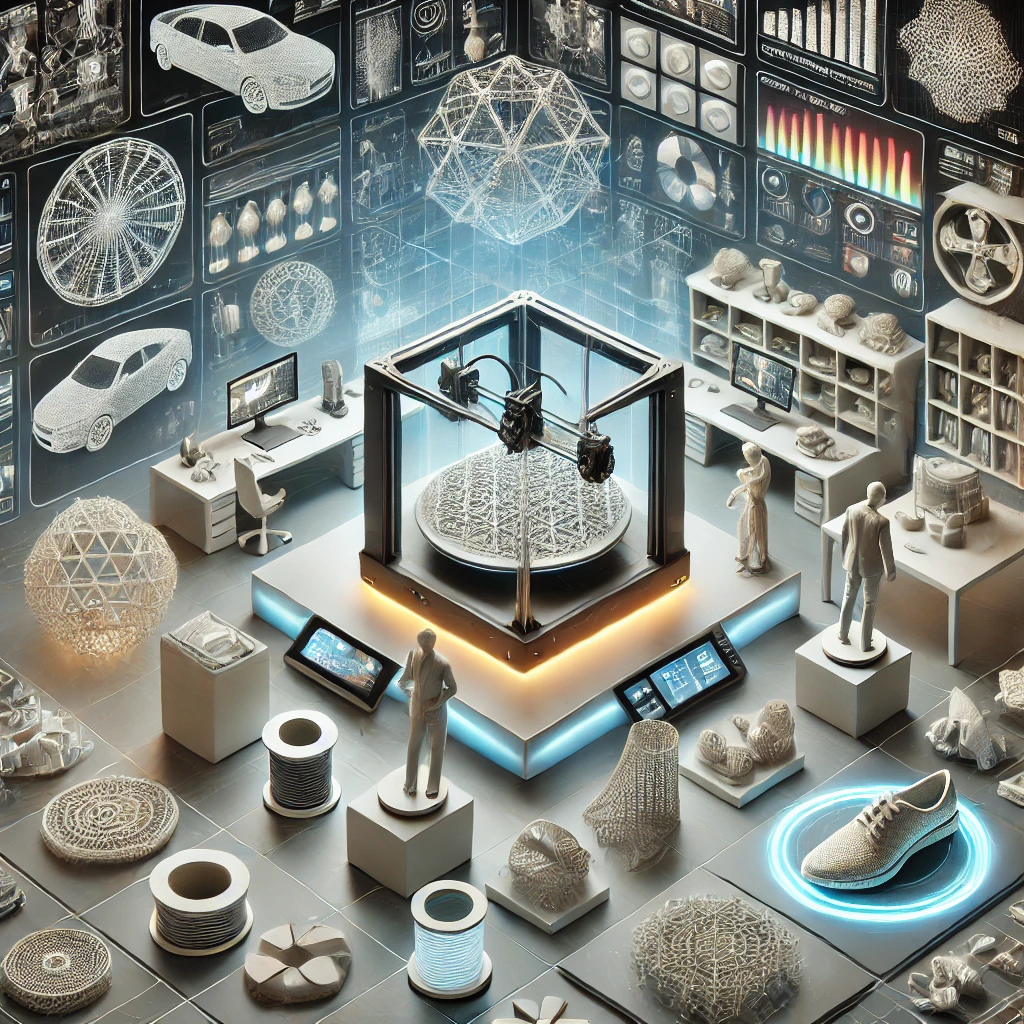
Explore 3D printing’s transformative impact on product design in 2024. Learn about its benefits, challenges, real-world applications, and future trends shaping industries globally.
The Evolution of 3D Printing in Product Design
3D printing, once a futuristic concept, has become a transformative force reshaping industries worldwide. Known formally as additive manufacturing , this technology builds objects layer by layer directly from digital designs, offering unmatched flexibility and precision. In recent years, industries such as aerospace, healthcare, fashion, and automotive have embraced 3D printing for both prototyping and full-scale production. In 2024, its impact on product design has reached unprecedented levels.
The key appeal of 3D printing lies in its ability to challenge traditional design and manufacturing norms. While traditional manufacturing processes like mold casting and machining often impose design constraints, 3D printing enables complex geometries and intricate features that were previously impossible to achieve. Today’s designers are no longer bound by the limitations of subtractive manufacturing; instead, they are empowered to “design without limits.”
With evolving consumer demands for personalized, sustainable, and innovative products, 3D printing has become a cornerstone of modern design practices. In 2024, businesses increasingly rely on this technology not only for prototyping but also for batch production and mass customization. Whether it’s a lightweight drone part or a custom medical implant, 3D printing has elevated product design to an entirely new level.
Moreover, advances in 3D printing materials—from bioplastics to metal composites —and machine capabilities have driven exponential growth in the application of this technology. Designers can now focus on both form and function , achieving a better balance between aesthetic appeal and technical performance. The reduced time to market has revolutionized industries, providing designers with an iterative design process that accelerates innovation.
This article explores the wide-ranging impact of 3D printing on product design in 2024. From fostering creativity and sustainability to streamlining workflows and tackling present challenges, we’ll dive deep into how this cutting-edge technology has become a driving force in reshaping the world of design.
Freedom of Design: Unlocking New Possibilities
One of the most prominent ways in which 3D printing influences product design is through its ability to enable freedom of design. Designers today are no longer restricted by the limitations of traditional manufacturing methods. Instead, additive manufacturing allows them to conceptualize and produce highly intricate geometries, lightweight structures, and organic shapes that would have been impossible—or extremely costly—using traditional production methods.
This newfound freedom empowers designers to pursue bold, innovative ideas. For example, 3D printing enables the creation of lattice structures , which are lightweight yet incredibly strong. These designs are commonly used in aerospace and automotive industries, where reducing weight without compromising structural integrity is critical. In traditional manufacturing, producing such geometries would require multiple expensive assembly processes, but with 3D printing, they can be achieved in a single step.
Customization is another area where 3D printing truly shines. Product designers can now create personalized solutions tailored to individual needs. From customized prosthetic limbs for healthcare patients to made-to-order furniture, the technology allows businesses to meet consumer demands for unique, one-of-a-kind products. This personalization drives customer satisfaction while building stronger brand loyalty in a competitive global market.
Furthermore, additive manufacturing allows designers to integrate multi-material solutions into a single product. Advanced 3D printers can now use different materials or colors in the same part, creating functional designs that combine aesthetics and technical performance seamlessly. For example, a shoe sole can be 3D-printed using rigid sections for stability and flexible materials for comfort—all without requiring separate manufacturing processes.
As we enter 2024, design freedom continues to be a major driver of adoption for 3D printing across industries. With newer tools such as generative design software that optimize form based on functional requirements, designers are pushing the boundaries of what products can look and feel like. This dynamic shift not only empowers creative professionals but also helps companies bring differentiated products to market more quickly.
Accelerating the Design Process
Time is one of the most valuable resources in product development, and in 2024, 3D printing is playing a critical role in accelerating the design process. Traditional manufacturing typically relies on costly and time-consuming methods like prototyping through mold fabrication or subtractive machining, which can take weeks or even months. By contrast, 3D printing allows designers to bypass these delays , printing functional prototypes in a matter of hours.
The reduction in prototyping timelines has immense implications for businesses. In fast-paced industries like consumer electronics or wearable technology, companies are under intense pressure to launch products as quickly as possible. 3D printing enables iterative processes, where designers can quickly test, refine, and optimize prototypes in a fraction of the time it once took. This rapid iteration leads to better products, as flaws can be identified and corrected earlier in the development timeline.
One emerging trend in 2024 is the adoption of virtual reality (VR) in conjunction with 3D printing. Designers now leverage VR to visualize their designs in a virtual space before bringing them to life with 3D printing. This integration streamlines decision-making, as designers and stakeholders can collaborate in real-time digital environments, eliminating miscommunications once common in traditional workflows.
Another significant advantage is the ability to produce multiple design variations simultaneously. For example, a furniture company can 3D-print multiple chair prototypes with different ergonomic features or aesthetic details in one batch. This approach enables better decision-making, as designers and customers can physically evaluate all options side by side. This level of speed and agility is nearly impossible using traditional manufacturing.
In 2024, the accessibility of desktop 3D printers has also democratized rapid prototyping. Freelancers, hobbyists, and small teams can now iterate faster than ever without relying on external manufacturers or high overhead costs. This self-sufficiency allows startups and small businesses to compete with larger enterprises by launching innovative products faster and more efficiently.
Cost Efficiency and Sustainability in Design
Another transformative effect of 3D printing on product design is its ability to deliver cost efficiency while supporting sustainable practices. Traditional manufacturing often involves significant waste due to excess materials, flawed prototypes, and over-production. In contrast, additive manufacturing reduces material usage by building items layer by layer, ensuring minimal waste. This shift has helped businesses cut costs while aligning their practices with global sustainability goals.
Material efficiency is particularly evident in industries working with high-cost materials such as titanium or carbon fiber composites, frequently used in aerospace or automotive sectors. In traditional methods, much of the raw material is discarded during machining. However, 3D printing avoids this waste entirely by using only the exact materials needed for the design, providing a more sustainable production cycle .
The impact extends beyond waste reduction. Many companies are now using eco-friendly 3D printing materials such as PLA (a biodegradable plastic derived from corn starch) to create sustainable products. In consumer goods, for instance, businesses have started producing items like wearables, packaging, and custom-designed home products using recyclable or biodegradable materials, marking a significant step toward reducing environmental footprints.
Cost efficiency is another clear advantage of 3D printing, particularly in short-run production or prototyping. Businesses no longer need to invest in expensive tooling or molds, which are typically required for traditional manufacturing. Instead, 3D printing supports on-demand production, allowing companies to fulfill orders as needed without the need for large-scale inventories. This reduces storage costs and lowers the risk of unsold products.
Lastly, the introduction of distributed manufacturing in 2024 is a game-changer. Companies can now decentralize production by sharing 3D printing files with local hubs or end-users equipped with printers. This eliminates long shipping distances, reducing carbon emissions and transportation costs. The result is a sustainable, cost-efficient design and production lifecycle that benefits both companies and the planet.
Industries Driving Innovation with 3D Printing
In 2024, nearly every industry is reaping the benefits of 3D printing, particularly in the realm of product design. The adoption of additive manufacturing spans a wide range of fields, including healthcare, automotive, aerospace, consumer goods, and even fashion. Each sector uses the technology to solve unique design challenges , fostering innovation and efficiency.
The healthcare industry continues to lead the way in leveraging 3D printing for life-saving advancements. Designers use the technology to create custom prosthetics, dental implants, and surgical guides tailored to individual patients. Additionally, medical researchers are exploring the use of bio-printed organs and tissue scaffolds —a revolutionary innovation that may redefine the possibilities of product design in healthcare.
The automotive and aerospace sectors rely heavily on additive manufacturing for lightweight components that reduce fuel consumption and improve performance. For example, engineers use 3D printing to manufacture geometrically complex brackets, air ducts, and turbine blades that optimize airflow and weight. In 2024, some automotive designers are also experimenting with 3D-printed concept cars that highlight innovation both aesthetically and functionally.
In the realm of consumer goods , leading brands are using 3D printing to create limited-edition shoes, glasses, or furniture that cater to niche audiences seeking personalized products. This aligns with growing consumer demand for products that reflect their individuality. Designers can now produce goods with unique textures, shapes, and colors while maintaining scalability for larger production volumes.
Fashion and jewelry have also embraced additive manufacturing in 2024. Designers are using 3D printing for intricate, one-of-a-kind pieces that would be impossible to create using traditional techniques. Jewelry pieces with extraordinary symmetry or clothing embellished with 3D-printed architectural patterns demonstrate how the line between art and functionality is becoming increasingly blurred.
Even the food industry is experimenting with 3D printing! From chocolate sculptures to lab-grown meat alternatives, chefs and product designers are pushing the boundaries of edible creations through additive manufacturing. The key takeaway: no industry is untouched by the transformative potential of 3D printing, and product design is at the forefront of this technological evolution.
Challenges and Limitations of 3D Printing in Design
Despite its transformative potential, 3D printing is not without its challenges. Designers often encounter technical, financial, and practical hurdles that must be addressed to fully unlock the benefits of additive manufacturing. In 2024, while significant progress has been made, limitations still exist that shape how 3D printing is integrated into product design workflows.
One key challenge is material science. While the range of 3D printing materials has expanded dramatically over the past decade, certain materials still lack the strength, heat resistance, or flexibility of their traditional counterparts. This limitation can pose challenges for industries such as aerospace or automotive, where material durability is crucial for functional performance.
Print speed is another bottleneck. While 3D printers are faster than ever, scalable production for mass manufacturing still lags compared to traditional methods like injection molding or CNC machining. Printing extremely intricate designs or larger components can take hours or even days, limiting the feasibility of using 3D printing in some fast-paced industries.
Cost barriers also remain for adopting high-grade industrial 3D printers. While desktop 3D printers are relatively affordable, industrial machines capable of producing complex products with advanced materials can cost tens or even hundreds of thousands of dollars. This financial upfront cost may discourage smaller businesses or startups from fully embracing the technology.
Another consideration is quality control. Due to the layer-by-layer nature of 3D printing, errors in the printing process can lead to structural weaknesses in the final product. Designers must invest time and resources into monitoring for defects and maintaining the calibration of their machines, making quality assurance an integral part of the workflow.
Finally, there’s the challenge of mainstream acceptance. While industries like healthcare and aerospace actively embrace 3D printing, some sectors remain wary due to concerns about reliability, scalability, and cultural biases towards traditional manufacturing. Convincing stakeholders of the technology’s long-term benefits requires continued advancements and clear demonstration of successful use cases.
The Future Outlook for 3D Printing in Product Design
Looking ahead
, the future of product design with 3D printing holds immense promise. In 2024, this technology is no longer considered a niche tool but a critical component of modern manufacturing ecosystems. Rapid advancements in materials, machine capabilities, and software are positioning 3D printing as an essential driver of innovation across industries.
One exciting frontier is the development of smart, multi-functional materials. Scientists are working on materials that can respond to external stimuli, such as heat, light, or pressure. Imagine a 3D-printed product that automatically adapts to its environment, enhancing its functionality. These “smart materials” could redefine how designers think about product applications in industries like fashion, health, and construction.
Artificial intelligence (AI)
will also become increasingly intertwined with additive manufacturing. AI-powered tools can analyze millions of design variables and suggest optimized structures that reduce weight, improve strength, or minimize material usage. Combining generative design with 3D printing allows designers to push innovation to unprecedented levels.
Mass customization will likely dominate many industries. With consumers craving unique, bespoke items, 3D printing will branch deeper into sectors like retail, gaming, and personalized healthcare. Accessible 3D design software paired with decentralized production hubs means that customization can be scaled globally, allowing businesses to cater to niche demands.
Furthermore, ongoing research into sustainable manufacturing methods shows immense potential. From recycled filaments to zero-waste production cycles, 3D printing will continue to align with the growing demand for eco-friendly solutions. In the next decade, industries aiming for net-zero emissions may view additive manufacturing as a core aspect of their strategy.
Finally, as costs for advanced printers and materials decrease, 3D printing will become more accessible to freelancers, startups, and educators than ever before. With these advancements, a new wave of innovation is poised to emerge, ensuring that product design will continue to break boundaries and evolve in remarkable ways.
Redefining Design Boundaries with 3D Printing
3D printing has fundamentally transformed product design, enabling unprecedented creativity, customization, and sustainability. In 2024, it stands as a pivotal technology that empowers industries to innovate faster, reduce waste, and craft products that cater to individual needs. Whether applied to prototyping or full-scale production, additive manufacturing is reshaping design philosophies and opening doors to entirely new possibilities.
From reducing prototyping timelines to enabling complex geometries and personalized consumer goods, the advantages are clear. But the challenges—such as material limitations, speed, and cost—remain obstacles that ongoing research and advancements aim to overcome. As industries continue to embrace 3D printing, its full potential will redefine how the world approaches product design.
As we look toward the future, 3D printing will be even more integrated into everyday life. Through collaboration between designers, engineers, and technology leaders, additive manufacturing will continue to challenge conventions and inspire innovations that push the boundaries of human ingenuity. In the world of product design, the possibilities are truly limitless.
For other insights and projects, be sure to explore our Key Technologies in 3D Printing or Uses of 3D Printing column

